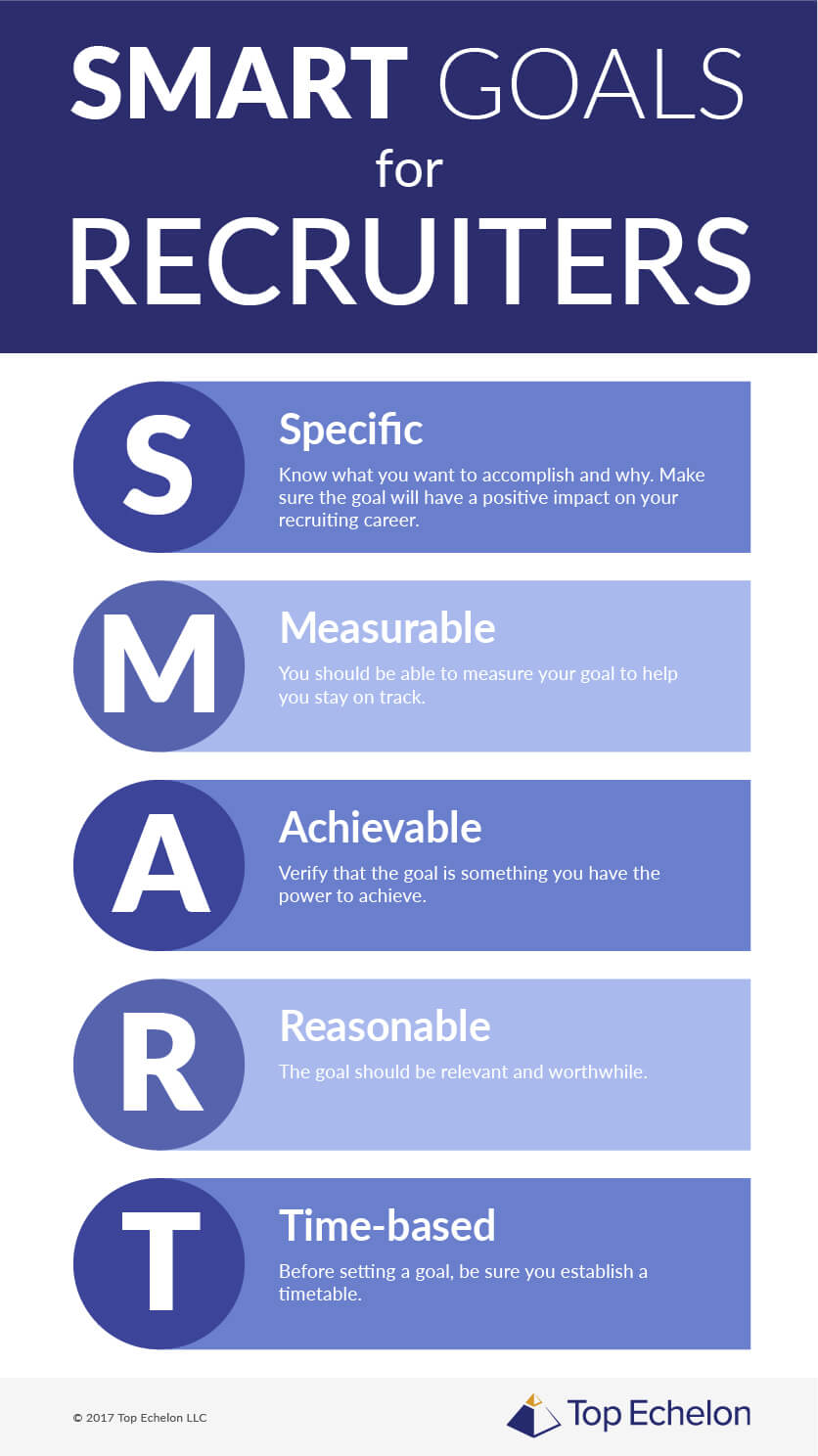Everybody sets goals. You might even set daily goals for yourself, like making sure you get that workout in or clean your home. But, what about recruiter goals? You should set recruitment goals to help motivate and encourage you in each of the recruitment steps involved in your day-to-day routine.
SMART goals for recruiters
The SMART acronym is a great tool to help you establish recruiter goals. Keep in mind the following before you pursue a goal:
- Specific: Know what you want to accomplish and why. Make sure the goal will have a positive impact on your recruiting career.
- Measurable: You should be able to measure your goal to help you stay on track.
- Achievable: Verify that the goal is something you have the power to achieve.
- Reasonable: The goal should be relevant and worthwhile.
- Time-based: Before setting a goal, be sure you establish a timetable.
Recruitment goals
What kinds of goals should you set as a recruiter? Goal setting for recruiters will frequently involve interconnected objectives. In order to reach one goal, you might need to work on another. If you need some ideas, check out these examples of SMART goals for recruiters:
1. Find and place top-notch candidates
Finding more qualified candidates with attractive skill sets is any recruiter’s dream. If you can improve the number of relevant candidates interested in your job orders, you improve your chances of getting more hired.
You can use different kinds of metrics to measure how well you reach this SMART goal. Maybe you decide that you want to find 10 additional top-notch candidates per job order you receive. And, you might want to improve your yearly placements by seven people. Make sure to measure and continually increase your goal if you find your methods work.
2. Decrease new hire failure rate
Placing a candidate isn’t the end of the process. Each client needs to see that the candidate is a good fit for their company, and the candidate wants to make sure they like their new job. Your placement is only one part of the overall staffing management plan.
One of your goals might be to decrease the new hire failure rate. Let’s say you had four placements who left a company relatively fast. You might establish a goal to decrease that number so more employees stay on with the company.
Achieving this goal might mean spending more time making sure a candidate will be a good fit for the client before you pass on their resumes. Ask the candidates situational questions about the job and how their backgrounds make them qualified for the job.
3. Streamline the recruiting process
Maybe you are having a difficult time keeping track of incoming candidate applications. Or, you are having a lull in finding qualified candidates. You might need to reorganize your approach to improve your recruiting game.
If you don’t have recruiting software, consider investing in a program. Recruiting software can help you keep track of applications, find candidates, and speed up the placement process. Staying on top of recruiting tasks with software is one step to streamline the recruiting process and achieve your SMART goal.
4. Improve candidate and client satisfaction
Do you provide assessments to see if your candidates and clients are satisfied with the recruitment process? If not, you might want to start and set goals for improving assessments.
To improve candidate and client satisfaction, work on developing stronger relationships with your clients and customers. With better relationships, you will learn exactly what your clients want out of their candidates and what candidates want out of a job.
5. Increase salary
If you’re like most recruiters, one of your goals is to earn more money than you did last year. One way to increase your salary is to fill more jobs before competitors can. Setting this as a goal is easily measurable.
In pursuing this goal, you might hit other goals, like placing the best candidates and satisfying your clients.
For example, you might establish a goal of increasing last year’s salary of $40,000 by 10% for the upcoming year. If you want to earn more money, you might also end up making more placements.
How to set recruiter goals
Here are some helpful tips to jumpstart your quest to setting goals:
List the goals
What is more helpful than a concrete reminder of your goals? Making a digital or paper list is a great way to keep in mind what you hope to accomplish. As you go, check off your goals so you can see your achievements.
Start small
If you decide you’re going to run your first marathon, do you expect to run 26 miles during your initial practice? In order to successfully reach your goal, you need to start small and improve little by little.
When you set recruitment goals, don’t try to do everything on day one. If your goal is to improve your placements by 50%, realize that you must set smaller goals each day, week, and month to eventually reach that goal.
Make a plan
Setting recruiter goals requires a plan. You need to know when you’ll achieve your goals and how to achieve them.
In your plan, you should include a timetable. For example, you might decide that your goal is to decrease the turnover rate of employees you recruited for clients. Each week, you could plan to lower the turnover rate by 1%.
You also need to discuss how you expect to reach your goals. If your goal is to reduce the employee turnover rate for your clients, you could say that you will spend an extra 10 minutes with your candidates, verifying they are the right fit before passing their resumes onto your clients.
Measure the goals
You need a way to track your goals, progress, and results. Make sure your goals are measurable. Measure your improvements or declines. For example, your goal might be to recruit 10% more top-notch candidates in the next month.
See if you reach the goals during the timeframe you created. After a month, you check your received applications and find that you received 12% more relevant candidates. Use applicant tracking software to help measure your progress and improve your search efficiency.
Keep in mind when setting recruitment goals…
Sometimes, you will not be able to reach your goals. If the reason is out of your control, don’t get discouraged. Either continue with the same goal, or create new goals that you might be able to control.
If you don’t reach your goals because of time constraints, keep a positive attitude. There will be times you exceed your goals and times when you can’t quite achieve them. The only failure is if you quit trying to reach your goals.










